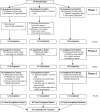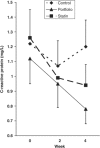Direct comparison of dietary portfolio vs statin on C-reactive protein
- PMID: 15900306
- PMCID: PMC7073252
- DOI: 10.1038/sj.ejcn.1602152
Direct comparison of dietary portfolio vs statin on C-reactive protein
Abstract
Background: 3-Hydroxy-3-methyl-glutaryl-coenzyme A (HMG-CoA) reductase inhibitors (statins) markedly reduce serum cholesterol and have anti-inflammatory effects. The effect of cholesterol-lowering diets on inflammatory biomarkers is less well known.
Objective: To compare the efficacy of a dietary combination (portfolio) of cholesterol-lowering foods vs a statin in reducing C-reactive protein (CRP) as a biomarker of inflammation linked to increased cardiovascular disease risk.
Methods: In all, 34 hyperlipidemic subjects completed three 1-month treatments as outpatients in random order: a very low-saturated fat diet (control); the same diet with 20 mg lovastatin (statin); and a diet high in plant sterols (1.0 g/1000 kcal), soy protein (21.4 g/1000 kcal), viscous fibers (9.8 g/1000 kcal), and almonds (14 g/1000 kcal) (portfolio). Fasting blood samples were obtained at weeks 0, 2, and 4.
Results: Using the complete data, no treatment reduced serum CRP. However, when subjects with CRP levels above the 75th percentile for previously reported studies (> 3.5 mg/l) were excluded, CRP was reduced similarly on both statin, -16.3 +/- 6.7% (n = 23, P = 0.013) and dietary portfolio, -23.8 +/- 6.9% (n = 25, P = 0.001) but not the control, 15.3 +/- 13.6% (n = 28, P = 0.907). The percentage CRP change from baseline on the portfolio treatment (n = 25) was greater than the control (n = 28, P = 0.004) but similar to statin treatment (n = 23, P = 0.349). Both statin and portfolio treatments were similar in reducing CRP and numerically more effective than control but only the change in portfolio was significant after the Bonferroni adjustment.
Conclusions: A combination of cholesterol-lowering foods reduced C-reactive protein to a similar extent as the starting dose of a first-generation statin.
Figures


Similar articles
-
Direct comparison of a dietary portfolio of cholesterol-lowering foods with a statin in hypercholesterolemic participants.Am J Clin Nutr. 2005 Feb;81(2):380-7. doi: 10.1093/ajcn.81.2.380. Am J Clin Nutr. 2005. PMID: 15699225 Clinical Trial.
-
Effects of a dietary portfolio of cholesterol-lowering foods vs lovastatin on serum lipids and C-reactive protein.JAMA. 2003 Jul 23;290(4):502-10. doi: 10.1001/jama.290.4.502. JAMA. 2003. PMID: 12876093 Clinical Trial.
-
Comparison of a dietary portfolio diet of cholesterol-lowering foods and a statin on LDL particle size phenotype in hypercholesterolaemic participants.Br J Nutr. 2007 Dec;98(6):1229-36. doi: 10.1017/S0007114507781461. Epub 2007 Jul 30. Br J Nutr. 2007. PMID: 17663803 Clinical Trial.
-
Justification for the Use of Statins in Primary Prevention: an Intervention Trial Evaluating Rosuvastatin (JUPITER)--can C-reactive protein be used to target statin therapy in primary prevention?Am J Cardiol. 2006 Jan 16;97(2A):33A-41A. doi: 10.1016/j.amjcard.2005.11.014. Epub 2005 Dec 1. Am J Cardiol. 2006. PMID: 16442935 Review.
-
Rosuvastatin, inflammation, C-reactive protein, JUPITER, and primary prevention of cardiovascular disease--a perspective.Drug Des Devel Ther. 2010 Dec 9;4:383-413. doi: 10.2147/DDDT.S10812. Drug Des Devel Ther. 2010. PMID: 21267417 Free PMC article. Review.
Cited by
-
The portfolio diet for cardiovascular risk reduction.Curr Atheroscler Rep. 2007 Dec;9(6):501-7. doi: 10.1007/s11883-007-0067-7. Curr Atheroscler Rep. 2007. PMID: 18377791 Review.
-
Changes in C-reactive protein from low-fat diet and/or physical activity in men and women with and without metabolic syndrome.Metabolism. 2010 Jan;59(1):54-61. doi: 10.1016/j.metabol.2009.07.008. Epub 2009 Aug 26. Metabolism. 2010. PMID: 19709693 Free PMC article. Clinical Trial.
-
Nut consumption and risk of stroke in US male physicians.Clin Nutr. 2010 Oct;29(5):605-9. doi: 10.1016/j.clnu.2010.03.005. Epub 2010 Apr 9. Clin Nutr. 2010. PMID: 20381933 Free PMC article. Clinical Trial.
-
Functional Foods as Modifiers of Cardiovascular Disease.Am J Lifestyle Med. 2009 Jul;3(1 Suppl):39S-43S. doi: 10.1177/1559827609332320. Am J Lifestyle Med. 2009. PMID: 20368755 Free PMC article.
-
Consumption of diets high in prebiotic fiber or protein during growth influences the response to a high fat and sucrose diet in adulthood in rats.Nutr Metab (Lond). 2010 Sep 29;7:77. doi: 10.1186/1743-7075-7-77. Nutr Metab (Lond). 2010. PMID: 20920272 Free PMC article.
References
-
- Albert MA, Glynn RJ, Ridker PM. Alcohol consumption and plasma concentration of C-reactive protein. Circulation. 2003;107:443–447. doi: 10.1161/01.CIR.0000045669.16499.EC. - DOI - PubMed
-
- Box GEP, Cox DR. An analysis of transformation. JR. Stat. Soc. (B) 1964;26:211–252.
Publication types
MeSH terms
Substances
LinkOut - more resources
Full Text Sources
Other Literature Sources
Medical
Research Materials
Miscellaneous

